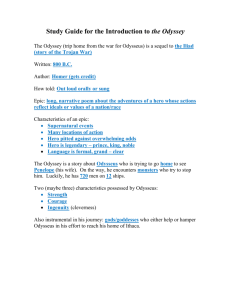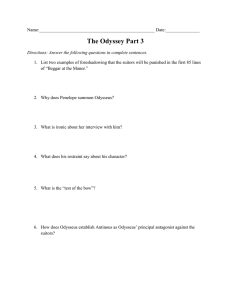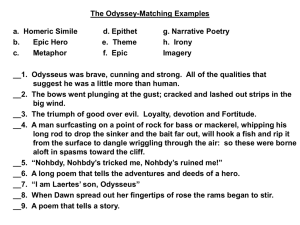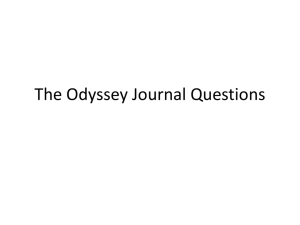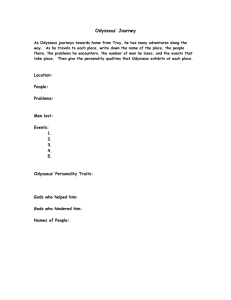here. - Viera English I & III Mrs. Connor
advertisement
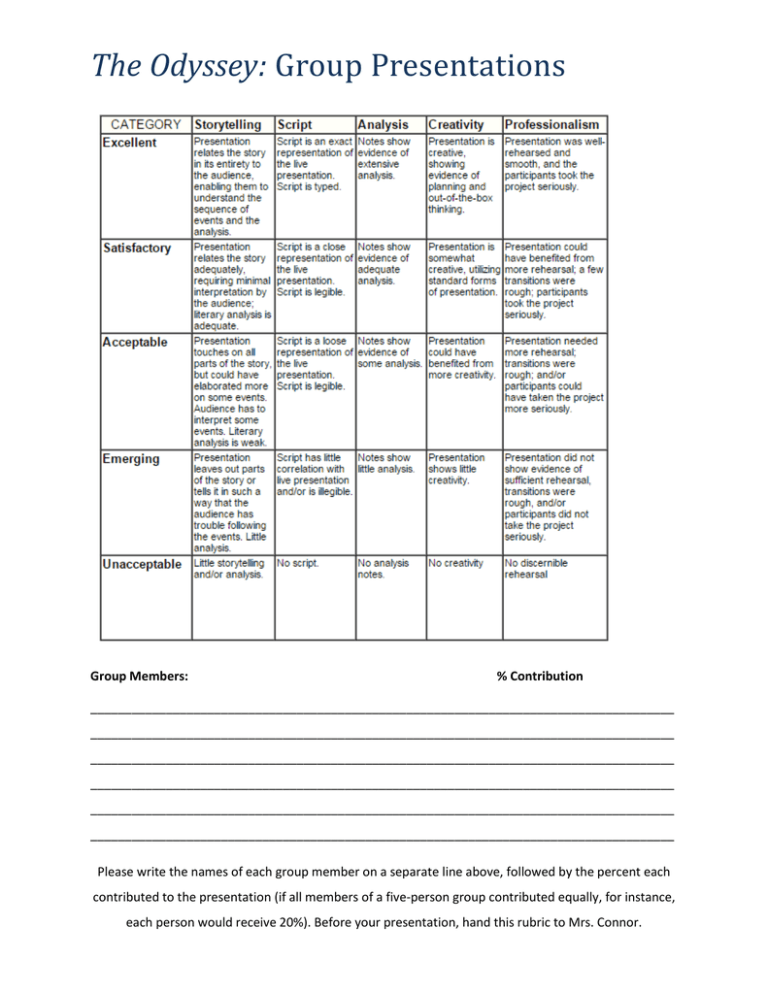
The Odyssey: Group Presentations Group Members: % Contribution _____________________________________________________________________________________ _____________________________________________________________________________________ _____________________________________________________________________________________ _____________________________________________________________________________________ _____________________________________________________________________________________ _____________________________________________________________________________________ Please write the names of each group member on a separate line above, followed by the percent each contributed to the presentation (if all members of a five-person group contributed equally, for instance, each person would receive 20%). Before your presentation, hand this rubric to Mrs. Connor. The Odyssey: Group Presentations How will you teach The Odyssey to the class? Read the passage carefully, taking notes on the parts you think should be included in the presentation. Do a literary analysis on the text, taking notes on o o o o o o o o Epic elements Character Does one character act as a foil for another? What can you infer about the characters from their actions? Dialogue – how does it contribute to the story? Setting – why does the poet choose one setting instead of another? How does it contribute to the story? Plot – what do the following contribute to the story? Foreshadowing Suspense Conflict Symbolism – what in the story might stand for something else? (E.g., the Sirens symbolize temptation) Figurative language (metaphor, simile, epithet, hyperbole, personification) Theme Decide which literary elements you will include with your story. Will you tell the story first and then relate the analysis, or include the analysis with the story? (Or maybe another strategy?) Choose a creative way to present your story and analysis. Drama, digital media, art, museum walk, lecture with question & answer (and a quiz?), giant board game . . . ? Script your presentation. Write out the words you will say (or present on screen), so that someone who wasn’t present has a good idea what you did. Build and rehearse your presentation. Turn in your analysis notes and your script before the presentation. Your goal is to entertain AND teach. Your “students” should be able to pass a quiz on the material you have presented. Book 17 A symbol is a thing that stands for something other than itself. Epics contain symbols to deepen meaning or convey an important idea. Look closely at the description of Odysseus’ faithful dog Argos. In what way might Argos symbolize Ithaca since Odysseus has been gone? Situational Irony involves a discrepancy between what is expected and what actually happens (e.g., Odysseus asks for a gift and is told he’ll be eaten last). Dramatic Irony occurs when the audience knows something the character doesn’t. Explain the dramatic irony of the scene in lines 27-41. Book 21 Penelope is an important character in her own right, although much of the poem so far has focused on Odysseus. Read lines 16-23. What do Penelope’s actions reveal about her? The first four books of the Odyssey, which we did not read, develop the plot of Penelope, Telemachus, and the suitors. The speech in lines 28-40 summarizes what has occurred over the past 20 years. What details explain Penelope’s conflict? What can you infer from her requirements for the contest? Odysseus’ disguise gives him the opportunity to observe the reactions of those around him. In lines 4159, why are the swineherd and cowherd described as “downcast?” What does their reaction lead Odysseus to do? Archetypal Characters such as Eumaeus and Philoetius appear frequently in epic literature. What trait do these two servants embody? Why is that trait especially valued by Odysseus at this time? Because an epic poem is a narrative, it includes the major parts of a plot (exposition, rising action, climax, falling action, resolution). In lines 80-93, what stage of the plot is approaching? In lines 94-102, the poet heightens the suspense. What is the primary conflict? In what way does dramatic irony (in which the audience knows something the characters don’t) add to the suspense? An epic simile is a comparison developed at length. In lines 105-114, explain the epic simile. Why is the simile appropriate? Why would lines 136-140 be considered an epic moment? Book 22 Epithets are words or phrases that point out traits associated with a person, giving the audience a deeper understanding of character. Identify the epithet in lines 1-4. What ideas are conveyed by this phrase? Apollo is the god of archers and the bow is his weapon. Why does Odysseus invoke the name of Apollo in lines 4-20? Why does Odysseus choose Antinous for his first shot? One theme conveyed in lines 9-13 might be that “death comes unexpectedly and in the middle of life.” What words describe the forcefulness of Odysseus’ shot? What is the purpose of this description? In lines 30-59, look for characters’ motivations as revealed through their dialogue. Why does Odysseus succeed in taking the suitors by surprise? What is the purpose of Odysseus’ speech in lines 34-40? Why does Eurymachus respond to Odysseus? A major characteristic of an epic is a battle described with specific details. In lines 80-106, how has the battle taken on epic proportions? What will victory require of Odysseus? In lines 109-118, the character of Telemachus is revealed. How does he conduct himself in the conflict? What does this conduct tell us about him? Book 23 In lines 14-30, Odysseus faces a conflict of a different kind. Why is this conflict different from his other struggles? Describe Penelope’s attitude toward Odysseus. Why does she feel this way? Symbols often help convey a theme. Describe the features of the bed in lines 40-51. In what way might this bed symbolize the marriage of Odysseus and Penelope? After the climax, the narrative moves to a resolution of the remaining conflicts. How has Penelope resolved her conflict? In what way does her solution show her to be well matched with Odysseus? Explain the epic simile in lines 81-89. Why is this simile apt considering Odysseus’ experiences?
